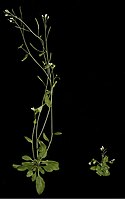
Photo from wikipedia
Poplar productivity is negatively affected by excess or deficit of water availability and by insect and pathogens that cause defoliation. Some foliar diseases, like leaf rust, produce defoliation at the… Click to show full abstract
Poplar productivity is negatively affected by excess or deficit of water availability and by insect and pathogens that cause defoliation. Some foliar diseases, like leaf rust, produce defoliation at the end of the summer. The interaction between water stress and defoliation is poorly understood. Hence, the aim of this work was to test if defoliation would have a stronger effect on growth, biomass and nutrient accumulation in well-watered plants than in water-stressed plants. The experiment started with 36 Populus deltoides unrooted cuttings, which grew outdoors in pots throughout a complete growing season. Water stresses (flooding and drought) were imposed from early summer when cuttings were established. Defoliation (50%) was applied at the end of summer when plants were acclimated to water stress. We analyzed photosynthetic parameters in response to water stress and biomass, nitrogen and phosphorus accumulation and partitioning at the end of the first growing season. Artificial defoliation produced similar reduction of plant height and aboveground biomass in the three water conditions; but in well-watered plants caused a strong decrease in belowground accumulation. Defoliation increased nitrogen resorption from leaves before abscission only in plants under drought, but it had no effect in nutrient resorption in well-water and flooded plants. Defoliation decreased nitrogen and phosphorus storage in every water condition. The results are relevant to manage poplars in environments with multiple stresses, because defoliation at the end of the growing season and water stress have relevant impact on plant growth, nutrient storage capacity and on the internal distribution of nutrients.
Journal Title: New Forests
Year Published: 2021
Link to full text (if available)
Share on Social Media: Sign Up to like & get
recommendations!